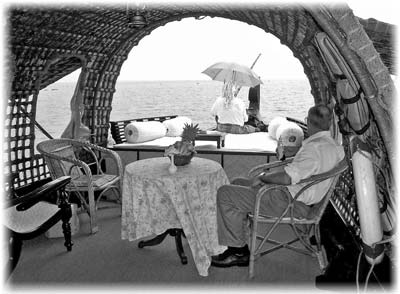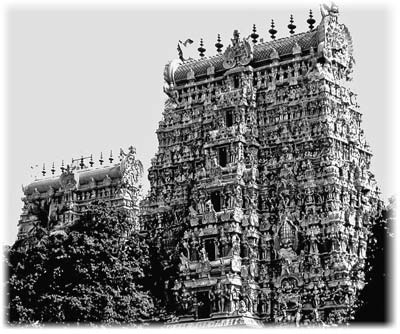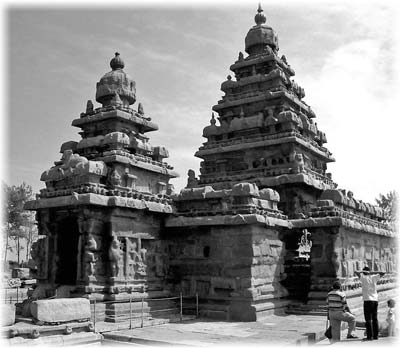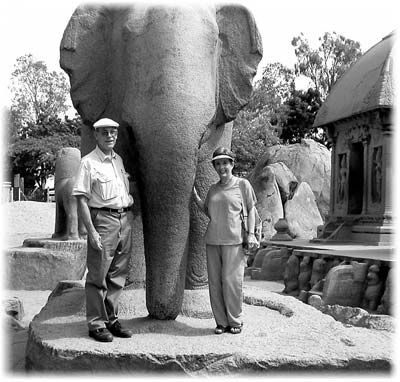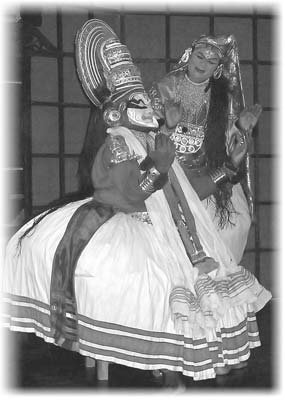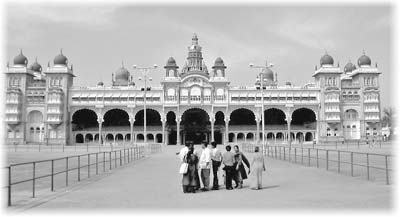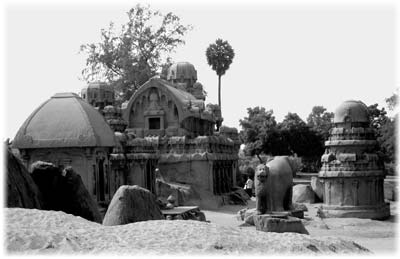Incredible India — The South
by Ian McGary, Mountain View, CA
Continued from last month's "Incredible India — The North"
After saying good-bye to our Philadelphia travel companions with whom we toured North India, my husband, Chuck, and I flew from Mumbai to Kerala at the southwestern tip of the country. The next two weeks of our tour were customized for just my husband and me.
There were several places in South India that I specifically requested to visit, but we also asked Barbara Sansone of Spirit of India (Mill Valley, CA; phone 888/367-6147 or visit www.spirit-of-india.com), who arranged our tour, for suggestions of places that she thought we would enjoy. Kochi (Cochin) was one of them.
Kochi
The city is situated on a collection of narrow islands and peninsulas along the edge of the Arabian Sea. For 2,000 years, Greek, Roman and Persian merchants came here to trade. Much later the Portuguese established themselves here, then the Dutch and the English.
The influence of the many peoples who settled in Kochi was apparent. For the first time, we saw Christian churches built using traditional Western architecture, such as the Santa Cruz Basilica and the St. Francis Church where Vasco da Gama was buried before his body was taken to Portugal.
The area known as Jewtown was one of the centers for the spice trade. There was a large Jewish community there at one time, but now there are only a few families living in the area as most have emigrated to Israel. We visited the Paradesi Synagogue and admired the hanging oil lamps and its floor of willow-pattern tiles brought from China. China’s influence can also be seen in the famous Chinese fishing nets that are still used in Kochi.
Situated on an island, our hotel, the Bolghatty Palace, was originally built by the Dutch in the 18th century.
Enjoyable excursions
A popular feature of Kerala culture that visitors can enjoy is a kathakali, or story play, performance. The plays are based on the Indian epics the “Ramayana” and the “Mahabharata” and are made up of universal themes, such as heroism and evil, poverty and prosperity, and cowardice and courage. The actors do not speak, but the story unfolds through their use of various gestures and facial expressions. The makeup and costumes identify the characters in the all-male cast. Musicians and singers tell the story.
Tourists were invited to see the actors apply their elaborate makeup before the show, and later an actor explained and demonstrated the facial expressions used during the performance.
A special pleasure in Kerala was an overnight voyage along the backwaters of Kochi aboard a kettuvallam, or converted rice boat. Many of the boats that were originally built to carry rice have been converted into houseboats. Our rice boat had a private bedroom and bath in addition to a peaceful sitting area where we were served meals that were cooked on board.
It was a welcome opportunity to drift through the quiet canals and see the villagers going about their daily lives.
On to Madurai
The next day we had a long drive across Kerala, where we passed rice fields, banana, coffee and tea plantations and sugarcane and coconut fields. We stopped at a rubber plantation and saw how the rubber is harvested from the tree.
When we reached our destination, the Periyar Tiger Reserve, we took a late-afternoon cruise to see some wildlife. Unfortunately, we did not see any tigers, but we were once again the only tourists on board and were able to blend into the Indian community for an hour or so.
One of the cities that I had requested a visit to was Madurai in the state of Tamil Nadu. There stands the enormous and spectacular Minakshi Sundareshvara Temple. It is dedicated to Shiva (known locally as Sundareshvara, the “handsome god”) and the powerful “fish-eyed goddess” Minakshi (an incarnation of Shiva’s wife), who is the protector of Madurai and the foremost deity worshiped in the area. She has a reputation as a uniquely generous goddess who gives boons to those who honor her, particularly those with requests regarding fertility and childbirth.
Four enormous, 9-story-high gopurams (ceremonial gateway towers) decorated with thousands of celestial and animal figures in painted stucco form the entrances to the temple complex enclosure. We witnessed the evening puja (worship) over which the temple priests preside. The god-image of Shiva is carried in a covered palanquin from his shrine to that of Minakshi’s for the night. This ceremony is accompanied by temple drums and blasts from the nagaswaram, the giant Tamil oboe.
The following day we toured the temple. We were asked to remove our shoes whenever we entered a mosque or a temple in India, usually leaving them outside with an attendant. This day we left our shoes in our car because there were too many visitors to safely leave them outside. I wished that I had brought an old pair of dark socks to wear for the times when we had to leave our shoes behind, since we visited so many religious sites. I could have disposed of them at the end of the trip.
Within the temple’s Thousand-Pillar Hall is the temple art museum, with many religious sculptures that have been moved there over time as new pieces were brought into the temple.
Within the main courtyard is a large tank, the Golden Lotus Tank, used for ritual bathing. An open colonnade surrounds the tank and it was there that we saw many family groups preparing for weddings.
The brides that we saw were wearing red; the grooms wore creamy white. Both were festooned with an abundance of flower garlands and surrounded by family and friends.
Kanchi
I also requested that Kanchipuram and Mamallapuram (Mahabalipuram) be included on our itinerary. These sites are also in Tamil Nadu and are near the Bay of Bengal on the western coast.
Kanchipuram (Kanchi) is a small temple town and is known as one of the seven sacred cities of the Hindus. The most famous and oldest temple there is the Kailasanatha Temple, built by the Pallava kings in the beginning of the late seventh century. It is dedicated to Shiva and displays many of the essential characteristics of the southern architectural style: a storied, pyramidal tower above the shrine, the use of a rectangular enclosure wall with gopurams, and a distinctive wall treatment using niches, with or without figures.
Recently, painted frescoes were discovered there and they were something that I particularly wanted to see.
After our sightseeing in Kanchipuram, our guide and driver wanted to stop at a local restaurant for lunch. When we entered, we saw a row of lavatory sinks along the wall. The patrons were seated at long tables and were using banana leaves for plates.
Attendants circulated and delivered scoops of rice on the leaves. Another came by with sauce and small spoonfuls of condiments. Diners, using their right hands, stirred the sauces into the rice and then made little balls of food that they popped into their mouths.
We had been told that the people in South India ate without utensils, but this was the first occasion on which we witnessed it. The lavatories, of course, were to wash hands both before and after the meal.
My husband and I refreshed ourselves with glasses of lassi (a sweet yogurt drink), but our driver and guide ate with great relish and pleasure.
Stony sites
Mamallapuram, also built by the Pallavas in the seventh century, was once a major port city. The site covers several miles and is a kind of stone city in which boulders and rock faces have been carved into buildings, animals and sculpted reliefs.
One immense relief, about 20 feet high and 80 feet long, contains over 100 figures of gods, men and beasts. The central (natural) cleft represents the Ganges River. The artists filled the space with nagas and naginis, snake beings associated with water.
The relief depicts a mythical story about a holy ascetic who performed great acts of austerity for a thousand years in order to persuade the gods to allow the river Ganges to flow down to Earth where it would bless mankind. The rock faces the water and was likely to have been one of the first monuments seen by the merchants and traders who came here.
The site also boasts the Five Rathas, rock-cut temples resembling wooden processional chariots of the gods.
Nearby is the Shore Temple (actually two temples, one facing east and the other, west), perched dramatically on a promontory in the Bay of Bengal. It was not carved of the living rock but was built up of granite blocks, thus it could have soaring towers.
The cell under the highest tower opens directly onto the sea, allowing the first light of the sun to illuminate it. It also allows sailors to pay homage to the god Shiva, to whom the east-facing temple is dedicated, from their approaching boats.
This is the earliest-known example of a stone-built temple in South India.
We stayed at a lovely resort on the Bay of Bengal, the Taj Fisherman’s Cove, exactly a month before the devastating Indian Ocean tsunami. This area was hit by the tidal wave, as were parts of Kerala. India suffered fewer deaths than Indonesia or Sri Lanka, yet there were reportedly about 10,000 victims in South India.
The Mamallapuram monuments and the Shore Temple withstood waves over 30 feet high, but all survived. Ironically, there were benefits resulting from the tidal wave here. The wave swept onto shore and filled the Shore Temple with sand. When the water receded, it took a good portion of the beach with it, revealing a large block of stone carvings, a much-eroded relief of an elephant and another structure which might have been part of a shrine.
Mysore
Our last stop was Mysore in Karnataka. The grandiose Indo-Saracenic Amba Vilas Palace was designed by an Irish architect and was largely built in the 19th century. After having seen the palaces in Rajasthan, we felt this one didn’t compare, even though it was lavishly overdecorated — a bit on the gaudy side.
The other site of note in Mysore is the Sri Chamundeswari Temple on Chamundi Hill overlooking the city. The female figures in silver repoussé on the doors show outstanding workmanship.
Down the hill was a natural phenomenon, a huge rock carved into a crouching Nandi (the bull, Shiva’s vehicle) that is 16 feet high and 25 feet long and lovingly decorated with flower garlands.
The details
Our entire month-long trip with Spirit of India — the group tour of North India and our customized private tour of the South — cost us about $6,000 per person without airfare. (I am not exactly sure of the total because there were some refunds as well as extra costs as hotel reservations changed.)
We flew home from Bangalore having seen a great deal of India, yet not the east nor north coasts. India is such a huge country that it has to be taken in bites.
What impressions did we take away with us? Most important, we found the people to be kind, generous and hospitable.
I was especially impressed with the rich colors we saw everywhere — the flowers, the fabrics, the colored powders, the vehicles, the brightly painted horns of the cattle — all in the service of everyday living. The women wear their brightly colored native dress for every occasion, even for work in the fields. The palaces and temple gateways are brilliantly painted and embellished with gold leaf.
All of these impressions and more made this visit one that we will never forget.


